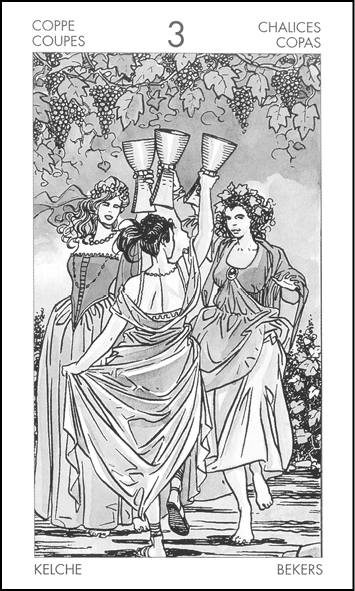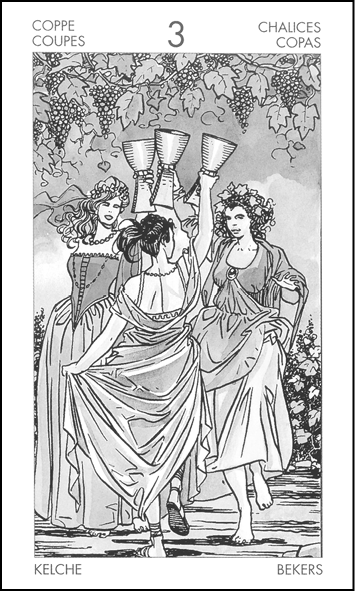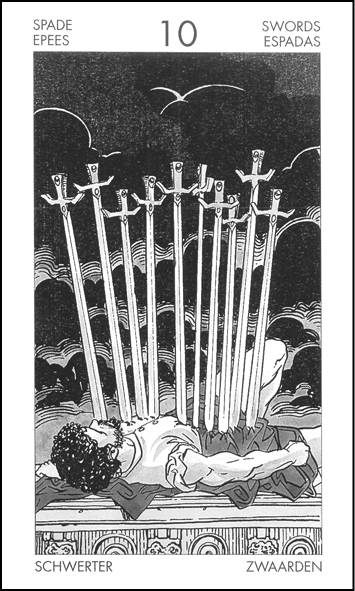

Facing the Crowd: Reading for Parties
and Groups
Over the last three decades, we have found that tarot is generally received openly and with enquiry by most people. We have not been subject to any negative press or public reaction, to our knowledge. This is partly because we always present tarot in an open and authentic spirit of interest, suitable for the audience. We never attempt to shock or mystify, to glamorise or apologise.
At one party, we did experience a totally unexpected reaction. Firstly, when someone asked about our profession and we started to explain a little bit about tarot, one person yelled out rudely, “Boring!” And so we decided to drop the subject. However, the partygoers, who were getting increasingly drunk, would not let it go. Later on that evening, two of them started smashing potato chips on the table and telling us, “Go on then, read them—read them!”
Whilst we declined to read the messy table, we made the point that we were tarot card readers and did not read chips—and neither did we read for chimps. As soon as it was practical and polite to do so, we left the party. We later learnt that this was a typical attack, not specifically on tarot but on anything that any so-called guest might have brought to the table that was not of interest to the hosts.
The moral of this story is that you cannot read for chimps, and neither should you automatically assume that it is tarot, or you personally, that is under attack.
In this chapter, we will look at ways of adding tarot into a party, gathering, or other social occasion; we will also share a number of fun and engaging games for use with other tarot enthusiasts. They will teach you about each other, and the tarot, at the same time as a lot of laughter goes on!
Incorporating tarot into a social scene can be a rewarding experience, although it can often be a fraught one if certain rules are not followed. We will start by laying out these rules of engagement, which as ever are based on our years of experience.
The Rules of Tarot Reading
at Parties or for Groups
Never read for someone in front of other
people, even if they have given permission
Whilst this may seem unnecessary, we ask that you trust us on this one: the cards can be very capricious, particularly when given an audience. Once Marcus was reading at a local fair when three young men and two young women came to his table. The youngest woman asked for a reading, and the others—to get their value—decided to listen in, with much joking and the permission of the woman getting the reading.
She asked the usual question, “What is going to happen with my relationship?” However, the object of her relationship was standing next to her. This should have raised an alarm; however, Marcus decided to press on with the reading. It had been a long day for no reward, so his mood was not the best—another warning sign.
As the reading progressed, it became apparent—and Marcus said so—that the relationship was very passionate, very physical, and very intense because of issues of control and dominance. This brought a great deal of blushing from the woman asking the question, and laughter from her friends. However, her partner was looking somewhat confused: this did not seem to be his experience of the relationship at all.
This was because—as Marcus again made clear from the cards—that the relationship being described by the cards was not with him: it was with someone else! At this point, in a scene that could have been a classic in any comedy film, everyone’s eyes turned to one of the other young men in the group. It was immediately apparent that everyone other than the so-called partner (of course) had known for some time that the woman was carrying on another relationship with someone else in their group. Of course, this immediately led to a bit of a scuffle and they chased out into the field to continue their “discussion” of the reading.
This incident was more than enough to convince Marcus never again to read before a group. The point is: you do not know what the cards will say, and if it’s something you cannot or should not say out loud, you will be placing yourself unnecessarily in a difficult situation.
Keeping the reading confidential—solely between the reader and querent, and the cards of course—also serves to preserve the mystery of tarot. This face to face engagement is always a unique and special moment and should not be subject to distractions. One solution might be to make a recording (given provisos of privacy and data protection) to play for others, should the querent wish to do so.
Always set a time limit for each reading
It is best that you set a time limit for each reading to ensure that you do not disrupt the party or gathering too much, should the gathering not be a stated “tarot party.” (There is nothing worse than becoming a “tarot bore.”) If tarot readings are a planned part of the event, setting a time limit for each reading also ensures that more partygoers are able to have one. Offering readings at a gathering only to disappoint several people who don’t get the opportunity is perhaps worse than not doing the readings in the first place.
You should also ensure the time is limited so that you can deal with any unexpected emotional issues arising from a reading (such as crying, shock, surprise, or outright joyous laughter) on the part of the querent.
Arrange for and take payment in advance
This saves trouble and potential embarrassment later on and gets the matter out of way, allowing you to concentrate on reading the cards and the guests to enjoy the readings. You should also have presented your terms and conditions (see our website at www.tarotprofessionals.com for professional membership where we supply a template of terms and conditions, in addition to a code of professional conduct and standards).
Agree on attendance numbers in advance
In practice, the main thing to remember with parties is often they have been arranged by one person and not everyone has the same beliefs about tarot. You may find that the number of attendees wanting a reading varies as people make up their minds, even during the event itself. Ensure that you have received a fixed payment. You can also make a small presentation before commencing readings to put people’s minds at rest and take general and common questions. This can be used to excite or calm the atmosphere in preparation for your style of reading.
Understand the environment
A hen-party is different than a stag-party. A private party in a mansion is different than a bar-gathering. You can often “case the joint” in advance and use the setting to your advantage. Also ensure that alcohol does not impair your enjoyment—whether drunk by others or yourself.
Methods and Activities
for Reading at Parties or for Groups
After introducing yourself as a tarot reader at parties or other social events, you will often be asked to perform a reading. If the conversation turns to previous bad readings or negative experiences that people have had with tarot, now is your chance to offer a positive engagement with the cards.
However, there may not be a place for a standard “across the table” reading, so we will discuss various methods of reading face to face, no matter what the circumstances. These have all been road-tested and tweaked over the years, so all you need is your deck to hand and a selection of methods from this toolkit.
The Oracular Sentence Method
This method is fun for lighthearted gatherings, New Year’s Day celebrations, birthdays, and other occasions where passing yourself off as a living oracle can be done in a semi-humorous way. It can even be hammed up, if you are so inclined, for Samhain/Hallowe’en parties. However, do not be fooled: this method can provide powerful oracular advice for its recipients, who can be “warned” that they must approach the oracle with some trepidation.
Divide your deck in advance into three piles: majors, minors, and court cards. Place the piles face-down, from left to right, on your table. They will form the structure of an oracular sentence composed of a noun (a major arcana card), a verb (a minor arcana card) and an adjective (a court card). You may wish to practice this method and incorporate your own variations.
Invite participants to come to you to receive your oracular insight. Tell them that they will be receiving a memorable message from the cards themselves, although it might be cryptic. The important thing is that it is a message that the cards have for them personally at this time.
Ask the participant to shuffle each of the three decks, keeping them face-down.
Select the top card from the first pile, the majors. Turn it over and say in your most oracular voice the name of the card. If, for example, you turn over the Tower, simply say “the Tower.” If you are moved in the moment to say something else, do so—however, for the method to work, it must be a noun (a name, an object, a thing). In this example, you might say “the change” or “the broken building.” Never deny an oracular moment; always say what feels true to you.
Now select a card from the second pile, the minor cards. This card (verb) says what the previous card (noun) is doing. For instance, if we pulled the Three of Cups, you might say “dances.” Add this verb to your noun and say it out loud, clearly and deliberately: “The Tower dances…” or “The change dances…”
Finally, select the top card from the third pile, the court cards, which gives you the adjective or descriptive word for how the action is being performed. If you drew the Queen of Cups, you might say “reflectively” or “dreamily.”
You can now utter the full oracular sentence in your best soothsaying voice: “The change dances dreamily…” At this point, if you feel moved to do so, add any poetic or divinatory statement that comes to you, such as: “The change dances dreamily, and what falls shall come to the dance if you have patience.”



The Tower, 3 of Cups, Queen of Cups (The Universal Tarot)



The Tower, 3 of Cups, Queen of Cups (The Universal Tarot)
As an advanced version of this method, you can perform this reading by taking the top cards from each pile as already described, then adding “but…” and taking the bottom three cards as a prophetic warning.
One recent performance of this method at a gathering produced what turned out to be a very meaningful oracle, off-the-cuff, when the following cards were drawn for a participant:
The oracular sentence was given as: “The Sun dances playfully, but the Moon stabs deliberately…”
The participant heard this as “the son” rather than “the sun” and it immediately gave her a revelation with regard to a family situation that had been troubling her. The fact that “the moon” was doing the “stabbing” very “deliberately” confirmed something very powerfully for her.
It is surprising how we can create such oracular moments in the most unlikely circumstances.
Telling a Person’s Story Method
When you don’t have space to lay down your cards—for instance, if you are standing up talking to somebody—and still wish to give them a demonstration of a reading, you can use this method, which forms a narrative or story for the person. In effect, it is a light version of the Golden Dawn’s “Opening of the Key” method, only a thousand times quicker. It builds on your earlier practice with storytelling (see chapter 2).






Top row: The Sun, 3 of Cups, and Page of Wands
Bottom row: The Moon, 10 of Swords, Queen of Wands (The Universal Tarot)






Top row: The Sun, 3 of Cups, and Page of Wands
Bottom row: The Moon, 10 of Swords, Queen of Wands (The Universal Tarot)
The advantage of this method is that you don’t need to lay down your cards anywhere to perform it, thus can be done standing, like on a bus, on a train, or in a queue.
Ask the participant for his name (if you don’t already know it), and then ask, “If your life were a book, what would the present chapter be called?” While this seems a fairly simple question, it is packed with deeper meaning and impact. The person may simply shrug and say “chapter 25” because he is aged twenty-five, or may give you a more revealing phrase such as “Falling Apart” or “A Time of Boredom.” Already you have, very simply, given his unconscious an empowering suggestion: that his life can be seen as a story in a book, with its own narrative flow, plot, challenges, and layers of meaning. By using such a familiar metaphor, we can bring tarot into an immediate and relevant engagement with popular culture outside of its usual boundaries in the gypsy fortuneteller’s booth.
Acknowledge his statement, and then say, “So if your life is now ‘chapter 25,’ who are you in the story?”
Shuffle the deck. Give it to the participant face-up. Now ask him to go through the deck, keeping it in order, to find the card that most feels like his image of himself in his life story. This may be any card—major, minor, or court. Whichever one he selects, this is his significator. This participation allows him to feel engaged in the reading.
Take back the deck and look at the two cards on either side of the significator. These two cards refer to the recent past of the participant that has led him to this present chapter. Briefly tell him what the cards say to you.
Then return the deck to the participant and ask him to shuffle it. You may say, “Let’s see what’s coming up in the next chapter…”
When he has shuffled, take the deck back, turn it face-up (if it isn’t already), and quickly go through the cards until you locate the significator. Read the two cards above and below it as the “next event” in the person’s life.
You can now steer this method in any direction to suit the time and circumstances. If the person wishes to ask a question about the “next chapter,” allow him to do so whilst shuffling the deck; then chase the significator down and read the two cards on either side of it. If he wants to know about a specific aspect of his life—the following “chapters” or anything else—apply the same method.
Impromptu Card Method
Another useful one-card method for reading for the general public in a social setting is the “Impromptu” method. It works very well with sceptics and those casually interested.
Shuffle the deck and ask the person to select a card. Ask them to look at it.
Regardless of the amount of interest they show in the card, ask them, “Does that mean anything to you?” No matter what their response, unless it is a strong affirmative, ask them to return the card to the deck, saying, “No, that’s not the card, then.”
Repeat this as many times as necessary until they find a card that holds meaning to them. Then interpret that card for them, encouraging the to participate in the interpretation. If they continue to show a lack of engagement, simply conclude by saying, “The cards have no message for you at this time.”
Activities for Tarot Enthusiasts
While the previous activities were directed toward a tarot card reader doing informal readings in a social setting, those that follow are more suitable for gatherings of tarot enthusiasts and students. Many of them are based on oracular games constructed by leading astrologer Lyn Birkbeck.20
The “What’s Going to Happen?” Game
This game challenges you to read for other people in a group and not get too panicked about your ability to read the cards—it is good to play this game as both a beginner and an expert!
A timekeeper is required. Lay out the tables, ideally in two facing lines, to ensure you can move around.
Facing each other in pairs, you quickly choose who is going to be reader and who querent. The querent always asks the same question, “What’s going to happen?”
Each reader takes three or four cards, as they wish, and reads them without positional meaning. The cards may suggest a time sequence, an overall meaning, or a simple sentence. Just make it up based on what you see.
The timekeeper allows just three minutes for the readings, then yells, “Change!” He or she can also use a klaxon, whistle, or bell.
Everyone on one side of the tables moves down one seat; those who have been readers switch to the role of querent, asking the same question and being read for in the same manner, for the same amount of time.
And verily is this like speed-divining. Have fun, make friends, don’t get too invested in the reading, and you may find words as sweet as honey even as you exhaust yourself.
Resolve a Family Issue Activity
Pull the court cards out of the deck before starting and set the rest of the cards aside. Ask the group if anyone has a family issue or argument that they would like to have clarity on. Ask this querent to think of the issue while shuffling the cards, then instruct her to look at them and pick out one from each suit. Read the cards in the context of the family issue.
Alternately, you can ask the members of the group to anonymously write down a question on a slip of paper and drop all the slips into a bowl. Ask one of the members to draw a slip out of the bowl at random, and then draw cards for the answer or resolution.
Oracular Poetry Activity
This fun activity can be used as a tool for tarot exploration in person with a group of friends, or online with your tarot social network. You will need pen and paper and the twenty-two major arcana cards.
Separate the majors from your tarot deck and set the other cards aside. Shuffle the cards, then ask someone to begin by choosing a card. In our example, we will choose the High Priestess. Instruct that person to hold the High Priestess card, clear his mind of any thoughts except what he sees in it, and then introduce himself to the card, either out loud or silently. Next, tell him to ask for a sentence or phrase of wisdom. Allow a moment or two for him to meditate on the card and allow the muse to speak through him. Once the person feels he is done, have him write the sentence or phrase at the top of a piece of paper, and then fold it over to conceal the message.
The tarot card and folded paper is then passed to the next person, who follows the same procedure. Keep passing around the paper and card until everyone has had at least one turn at saying what they think the High Priestess card is seeing, speaking, and sharing with the group.
The following was revealed to a group of four after going around the circle twice:
- I am the High Priestess; I sit between two worlds. I watch and patiently wait for the time when I can reveal the secrets of what lies behind me and beyond me.
- She is mysterious and enigmatic and knows the secrets of the sea.
- Pomegranates and pillars, veils and vision.
- I see her stare at me silently.
- The secrets that I bear within weigh me down.
- The ocean is as deep as it is wide and vast.
- I ate the seeds of creation to transform the world above and below.
- She wants me to bear her mystery.
Use your intuition to make sense of the message. Alternately, you can have each person draw a fresh card for inspiration, rather than passing the same card around.
Name That Card Activity
This activity is meant to hone your observational skills, and is directed toward experienced tarot readers. It helps people become more familiar with the cards in a fun and informative way. We suggest starting with the Rider-Waite-Smith deck, which is well known to most readers. Once you get the hang of it, try it with other decks.
Blindfold one member of the group and place a tarot deck in her hands. Instruct her to shuffle the deck, take out a card, and hold it up to the group. The other members of the group take turns saying what they see on the card, while the blindfolded person must guess it based on the clues given.
Let’s use the Knight of Pentacles as an example. Here are some typical responses:
- The card has a yellow background
- Rolling hills in the background
- Red glove
- Suit of armour
- Pentacles
To make a contest of it, have each blindfolded participant state, before starting, how many clues they will need in order to guess the card, kind of like the old “Name That Tune” game. See how many turns it takes for you to become better acquainted with your deck of choice.
Alphabet Tarot Activity
Take a card from the deck and hold it up to the group, for example, the Queen of Cups.


The Queen of Cups
(The Universal Tarot)
Choose a person to start with the first letter of the alphabet, A, and give a word beginning with A that describes the card. The next person will describe the card using a word beginning with B, and so on:
A: Amorous
B: Bountiful
C: Crestfallen
D: Deliberation
E: Elegant
F: and so on…
Just a Minute Activity
Draw a card randomly. Each person has to talk for one minute about that card without using the same word twice, pausing, or getting off track about the theme of the card. You might want to define how long a pause is acceptable, such as more than five seconds. The first person in the group to catch the speaker repeating words, pausing longer than five seconds, or going off topic then takes over the subject. Alternately, each person can draw a new card when it’s his turn to speak.
Five Things Activity
Each person is instructed to pick a theme or concept, and to choose five cards from his or her deck that correspond to these things. Don’t choose randomly; look at the cards and choose based on their images, symbolism, or meaning. Give the others a spoken clue and show them the cards one by one. The object is to guess the theme or concept. The first person to guess correctly then takes his or her turn.
For example, let’s use the concept “holidays” (“vacations” to you Americans). What ideas do you associate with a holiday or vacation? They might include taking a rest, getting away from the stresses of life, traveling to new places, spending special time with family and friends, enjoying good food and drink, and doing fun activities.
A spoken clue for this example might be, “Most people do this particular thing once a year.”
Give this learning game a go, and you will be pleasantly surprised by how quickly your knowledge of the cards increases.
Liar’s Tarot Activity
This game is for an intermediate group that knows a little about tarot. Draw a card and describe it for the rest of the group to guess—but feel free to sneak in a fib about its meaning. Say, for instance, that the card is the Page of Pentacles. You might say, “I am a page; I am young, enthusiastic, and proud of what I am. I am fast to invest. I have ambition and dreams of what lies beyond.”
The group responds by calling out “truth” or “lie.” Once somebody has spotted a lie, he or she takes over with a new card, and so on.
Tarot Truth or Dare
In a simple variant on the old game of “truth or dare,” participants draw a card and someone else in the group gives them the choice of truth or dare. The truth or dare has to be relevant to the card chosen; so for example, a dare based on the Eight of Wands might be to send a prank text or e-mail to a close friend, or a suggestive one to a romantic interest, as suggested by the group!
Tarot Card Charades Activity
This is for experienced readers who will have to mime a reading using one to three cards, dependent on their skill level, within a three-minute period, until competing teams correctly guess the cards involved. You can simplify this game by using only majors, only minors, or only court cards, or even just the minor cards of one particular suit. There is only one rule: you cannot simply hold up the number of fingers for the number on the card and then mime a pentacle, cup, sword, or wand in the air!
We hope this chapter encourages you to find fast, fun, and friendly ways of introducing tarot into social events and gatherings. With a few common-sense rules and simple methods, you can easily share tarot with just about anyone, in all kinds of circumstances.